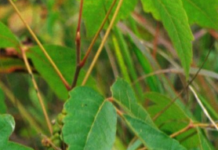https://hnr.k-state.edu/extension/info-center/newsletters/index.html
Blog Post: http://www.ksuhortnewsletter.org
Video of the Week: When to Pick Tomatoes
https://kansashealthyyards.org/all-videos/video/when-to-pick-tomatoes
UPCOMING EVENTS
The Kansas Turf & Ornamental Field Day will be held Thursday, August 4 at the John C. Pair Horticulture Research Center (1901 E. 95th St. S., Haysville, KS)
The field day program is designed for all segments of the turf & ornamentals industry – lawn care, athletic fields, golf courses, landscape, nursery, and grounds maintenance. Included on the program are research presentations, problem diagnosis, commercial exhibitors, and equipment displays. There will be time to see current research, talk to the experts and get answers to your questions.
One hour of pesticide recertification credit in both 3A and 3B are available, as well as GCSAA education points.
For more information, go to www.kansasturfgrassfoundation.com, or you can register online at https://2022turfday.eventbrite.com
REMINDERS
• Tomatoes can be harvested when they are ½ green and ½ red to prevent sunscald and to allow the development of a deeper red color during hot weather. The fruit will have the same quality as if it were vine ripened if allowed to ripen inside.
• Can plant potatoes if you have a source of seed potatoes.
• Can plant cabbage, broccoli and cauliflower from seed to be transplanted later.
VEGETABLES
Tomato Cracking
Tomatoes often have problems with cracking caused by pressure inside the fruit that is more than the skin can handle. Cracks are usually on the upper part of the fruit and can be concentric (in concentric circles around the stem) or radial (radiating downward from the stem). We don’t know everything about cracking but here is what we do know.
Tomatoes have a root system that is very dense and fibrous and is quite efficient in picking up water. Unfortunately, the root system can become unbalanced with the top of the plant. Early in the season it may be small in relation to the top growth resulting in blossom-end rot when the weather turns hot and dry. Later it may be so efficient that it provides too much water when we get rain or irrigate heavily after a dry spell. This quick influx of water can cause the tomato fruit to crack. Therefore, even, consistent watering can help with cracking. Mulching will also help because it moderates moisture levels in the soil. However, you can do everything right and still have problems with cracking in some years.
We have evaluated varieties for cracking during our tomato trials at K-State. It takes several years worth of data to get a good feel for crack-resistant varieties but we have found some real differences. Some varieties crack under about any condition and others are much more resistant. The difference seems to be pliability of skin rather than thickness — the more pliable the skin the more resistance to cracking.
The old variety Jet Star has been the most crack resistant of any we have tested including the newer types. Unfortunately, Jet Star is an indeterminate variety that puts out rampant growth.
Newer varieties with more controlled growth are often more attractive to gardeners. Mountain Spring, Mountain Pride, Mountain Fresh, Floralina and Sun Leaper are smaller-vined types that have shown good resistance to cracking. (Ward Upham)
How to Pick a Ripe Melon
Telling when a melon is ready to be harvested can be a challenge, or it may be quite easy. It all depends on the type of melon. Let’s start with the easy one. Muskmelons are one of those crops that tell you when they are ready to be picked. This can be of help to not only harvest melons at the correct time but also choose good melons when shopping. As a melon ripens, a layer of cells around the stem softens so the melon detaches easily from the vine. This is called “slipping” and will leave a dish-shaped scar at the point of stem attachment. When harvesting melons, put a little pressure where the vine attaches to the fruit. If ripe, it will release or “slip.”
When choosing a melon from those that have already been harvested, look for a clean, dish-shaped scar. Also, ripe melons have a pleasant, musky aroma if the melons are at room temperature (not refrigerated).
Watermelons can be more difficult and growers often use several techniques to tell when to harvest.
1. Look for the tendril that attaches at the same point as the melon to dry and turn brown. On some varieties this will need to be completely dried before the watermelon is ripe. On others it will only need to be in the process of turning brown.
2. The surface of a ripening melon develops a surface roughness (sometimes called “sugar bumps”) near the base of the fruit.
3. Ripe watermelons normally develop a yellow color on the “ground spot” when ripe. This is the area of the melon that contacts the ground.
Honeydew melons are the most difficult to tell when they are ripe because they do not “slip” like muskmelons. Actually, there is one variety that does slip called Earlidew, but it is the exception to the rule. Ripe honeydew melons become soft on the flower end of the fruit. The “flower end” is the end opposite where the stem attaches. Also, honeydews should change to a light or yellowish color when ripe, but this varies with variety. (Ward Upham)
FRUIT
Netting Grapes
If you have grown grapes before, you have likely discovered that birds like grapes as much as you do. There are two methods homeowners can use to protect the fruit. The first is bagging where a paper bag is placed over the cluster and secured with a twist tie or staple. The bag can be left until it is time for harvest as flavor and color are determined by sunlight hitting the leaves rather than the cluster.
The second method is to net the crop. The most common and least expensive netting is the lightweight, black, polypropylene type with a square mesh size of ½” x ½”. This can be difficult to install and remove as it tends to stick to itself and to the vines. However, it is effective. Woven mesh bird netting is also effective and easier to work with but is more expensive.
If your trellis has a wire at six feet high, purchase a net that is at least 14 feet wide so that it can be draped over the grapes and secured along the bottom edge with clothes pins. Nets that are 17 feet wide are less common but give more material to work with and are therefore easier to secure. (Ward Upham)
Green June Beetle
These large beetles feed on sweet corn, blackberries, and peaches. They look much like the common May beetle, or June bug, but have a dull, velvety green color. The underside is more of an iridescent green. These beetles have poor navigational skills and seem to fly until they hit something. They also make a buzzing sound somewhat like a bumblebee. Unfortunately, they are also about the size of a bumblebee and so cause concern for many gardeners even though they cannot harm people. As noted above, they may damage crops.
A number of general-use insecticides, including carbaryl (Sevin dust) and malathion, may be used to discourage feeding. See table below for what can be used and the number of days between application and harvest.
Insecticide Peaches Blackberries, raspberries Sweet Corn
Carbaryl* 3** 7 2
Malathion 7 1 —–
* Carbaryl is found in Sevin Ready to Use and Sevin Dust but not in Sevin Ready to Spray or Sevin Concentrate.
** Days to harvest
Carbaryl has a two-day waiting period between spraying and harvest on sweet corn and a three-day waiting period on peaches. There is a seven-day waiting period for Sevin on blackberries, so malathion, with a one-day waiting period, may be a better choice. (Ward Upham)
Raspberries and Blackberries After Harvest
Raspberries and blackberries are perennial plants with biennial canes. What that means is that though the plants live year after year, each individual cane only lives two years. Most commonly the first year canes, referred to as primocanes, grow but don’t fruit. Primocanes become floricanes the second year. Floricanes fruit and then die.
So what do you do with these dead canes when they die after fruiting? Though many gardeners leave the canes for removal the following spring, it is best to remove them immediately after they die if your plants have had problems with disease such as anthracnose (see photo). See https://ohioline.osu.edu/factsheet/plpath-fru-27 . Remove the canes as close to the ground as possible without damaging the primocanes. It is best to discard, burn or bury any infected canes. (Ward Upham)
Tan or White Drupelets on Blackberry and Raspberry Fruit
Blackberry and raspberry fruit will often develop white or tan drupelets on the berry. Though we are not completely sure of the cause it appears to be an interaction between genetics and the environment. Possible environmental factors include high temperatures, low humidity, stinkbugs, wind, UV light and rainfall. Regardless, the eating quality of the fruit is not affected.. (Ward Upham)
PESTS
Walnut Caterpillars
If you notice leaves disappearing from walnut trees, it may be walnut caterpillars. Walnut caterpillars attack primarily black walnut, pecan, and several species of hickory trees, but may also attack birch, oak, willow, honey locust, and apple trees.
Walnut caterpillars overwinter as pupae underground beneath host trees. In late spring, moths emerge and deposit egg clusters on lower leaves. By the end of June, newly emerged and gregarious larvae skeletonize leaves. Larger hairy, brick-red larvae consume greater amounts of leaf tissue, and nearly matured gray larvae devour entire leaves, including petioles.
As mentioned earlier, walnut caterpillars are gregarious. In other words, they feed in groups. A single tree may contain several groups. When disturbed, larvae arch their bodies in what looks like a defensive move. Larvae crowd together on the lower parts of trees to molt and leave an ugly patch of hairy skins. Mature larvae, 2 inches long, descend or drop to the ground where they enter the soil to pupate. A second generation occurs soon, creating the overwintering pupae.
Removing leaves with egg masses is an effective way to control walnut caterpillars. This may be impractical with large trees or when too many infested leaves are present. Bands of Tree Tanglefoot pest barrier may be used to snare larvae as they migrate to main branches or the trunk to molt. Insecticides such as spinosad (Natural Guard Spinosad, Captain Jack’s Deadbug Brew, Bonide Colorado Potato Beetle Beater and Monterey Garden Insect Spray) permethrin (numerous trade names) malathion or cyfluthrin (Tempo, BioAdvanced Vegetable and Garden Insect Spray) may provide the most practical means of control. The spinosad products are organic controls. (Ward Upham)
Contributors: Ward Upham, Extension Associate
Division of Horticulture
1712 Claflin, 2021 Throckmorton
Manhattan, KS 66506
(785) 532-6173
For questions or further information, contact: [email protected] OR [email protected]
This newsletter is also available on the World Wide Web at: http://hnr.k-state.edu/extension/info-center/newsletters/index.html
The web version includes color images that illustrate subjects discussed. To subscribe to this newsletter electronically, send an e-mail message to [email protected] or [email protected] listing your e-mail address in the message.
Brand names appearing in this newsletter are for product identification purposes only. No endorsement is intended, nor is criticism implied of similar products not mentioned.
K-State Research and Extension is committed to making its services, activities and programs accessible to all participants. If you have special requirements due to a physical, vision or hearing disability, or a dietary restriction please contact Extension Horticulture at (785) 532-6173.
Kansas State University Agricultural Experiment Station and Cooperative Extension Service K-State Research and Extension is an equal opportunity employer. Issued in furtherance of Cooperative Extension Work, Acts of May 8 and June 30, 1914, as amended. Kansas State University, County Extension Councils, and United States Department of Agriculture
Cooperating, Ernie Minton, Dean.





